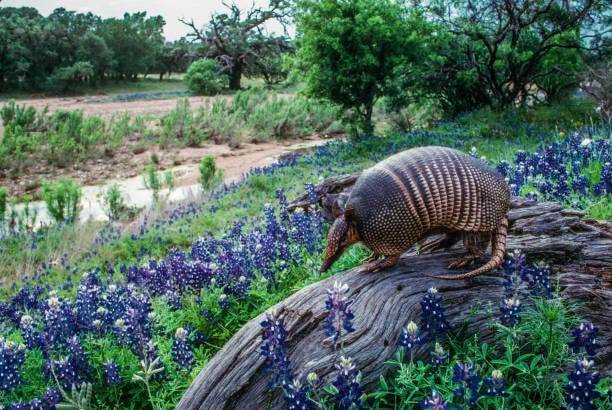(Almost) Everything You (Secretly) Wanted to Know About the Nine-Banded Armadillo
[The nine-banded armadillo] is a “true Texan” . . . tough, pioneering, adaptable, and it generously shares its habitation with others. –Larry L. Smith & Robin W. Doughty
Y’allogy is an 1836 percent purebred, open-range guide to the people, places, and past of the great Lone Star. We speak Texan here. Y’alloy is free of charge, but I’d be grateful if you’d consider riding for the brand as a paid subscriber.

For most folks, Texan and non-Texan alike, the only encounter with the official small mammal of Texas is swerving to avoid running over an armadillo. Those who hit one soon learn that the four-legged tank-like critter is in fact no tank—especially when faced with a half-ton pickup traveling at highway speeds down some lone country road.
Despite it’s poor performance against a speeding vehicle, however, the nine-banded armadillo is quite a remarkable animal—as this list of ’dillo facts shows. Its fancy Latin name is dasypus novemcinctus, which literally means “hairy-footed, nine-girded rabbit.” The Aztecs also referred to the armadillo’s rabbit-like quality, calling it a “turtle-rabbit.” In Spanish armadillo simply means “little armored one.”
For more than a century, scientists who’ve studied the little armored critter believed there was only one species in North America. But in 2024, while conducting DNA research on the nine-banded armadillo, scientists came to the conclusion that it is actually a distinct species and have given it a new name: dasypus mexicanus—the “Mexican long-nosed armadillo.” Or as I like to call it, the “hairy-footed Mexican.”
Now, let’s see what we can dig up about Texas’ official state small mammal—the nine-banded armadillo.*
Nine-banded armadillos are not native to Texas, but like many others, they got here as fast as they could. They migrated from South America, through Central America and Mexico, and crossed the Rio Grande sometime in the 1850s.
Nine-banded armadillos can be found throughout Texas, but don’t inhabit the Trans-Pecos region—far West Texas—and are rarely seen in the Panhandle.
Nine-banded armadillos are capable of “virgin births.” The female is able to delay implantation of the fertilized egg during times of stress. When she does give birth, armadillos produce litters of identical quadruplets—for those who don’t know big words like “quadruplet” that’s four baby armadillos per litter, all of the same sex. When they’re born, baby ’dillos have soft shells that harden as they mature.
Nine-banded armadillos are rabbit-like, as the Aztecs observed. ’Dillos can jump upwards to four or five feet when startled.
Nine-banded armadillos are champion nappers, sleeping upwards to sixteen hours a day.
Mature nine-banded armadillos measure two to three feet in length—nose to tail—and weigh ten to twelve pounds.
Nine-banded armadillos have very low body temperatures, making them ideal creatures for the study of leprosy, but also making them susceptible to frostbite.
Though nine-banded armadillos have superior smell and hearing, they have inferior eyesight, so they rarely come out during the day, unless it’s overcast or near dusk—making them susceptible to roadkill.
Contrary to popular opinion, nine-banded armadillos do not protect themselves by rolling up in a ball. They run from danger. Only the La Plata three-banded armadillo of South America is capable of balling up.
Nine-banded armadillos can hold their breath up to six minutes, allowing them to walk underwater. They can also inflate their intestines, by gulping air, to make themselves buoyant so they can dog-paddle across streams and rivers.
’Dillos have long been a source of meat in Texas’ past and among rural folk. During the Great Depression they were considered the “poor man’s pig” for its pork-like taste and were called “Hoover Hogs”—after President Herbert Hoover, who was in office at the beginning of the Depression.
Early German settlers in Texas, as well as World War II German prisoners in Texas, called the nine-banded armadillo: panzerschwein—“armored pig.”
Nine-banded armadillos are great marketers. During the heyday of Austin cool, in the 1970s, the most famous music venue was named after the lowly hairy-footed Mexican—Armadillo World Headquarters. And for a time, ’dillos were the official spokescritter for the National Beer of Texas—Lone Star.
Well, there you have it, (almost) everything you (secretly) wanted to know about the nine-banded armadillo. Before we leave the ’dillo den, however, one piece of advice to non-Texans: don’t confuse Amarillo and armadillos. Amarillo is a town in the Panhandle. Folks there are friendly, dirt-digging farmers or dirt-slinging cowboys and tend to be right of the road. Armadillos are shy, dirt-digging creatures and tend to be middle of the road.
* The nine-banded armadillo was designated the state’s small mammal by the 74th Legislature in 1995. The flying mammal is the Mexican free-tail bat (Tadarida brasiliensis). The large mammal is the Longhorn (Bos Texanus).
J. W. Loughry and Colleen M. McDonough, The Nine-Banded Armadillo: A Natural History (Norman: University of Oklahoma Press, 2013).
Larry L. Smth and Robin W. Doughty, The Amazing Armadillo: Geography of a Folk Critter (Austin: University of Texas Press, 1984).
The 1836 Percent Y’allogy Guarantee: This newsletter is created by a living, breathing Texan—for Texans and lovers of Texas. It exists thanks to the generosity of its readers. To ensure it continues, I invite you, if you’re able and haven’t already done so, to ride for the brand as a paid subscriber, give the gift of Y'allogy to a fellow Texan, or purchase my novel.
Much obliged, y’all.



Speaking of Lone Star beer, known as the National Beer of Texas — it is also commonly referred to as "horse piss." For Texans this does not seem a contradiction.
Quite possibly my favorite article yet. If I had to choose between being infested with feral hogs or armadillos, I'd pick the 'dillos every time.